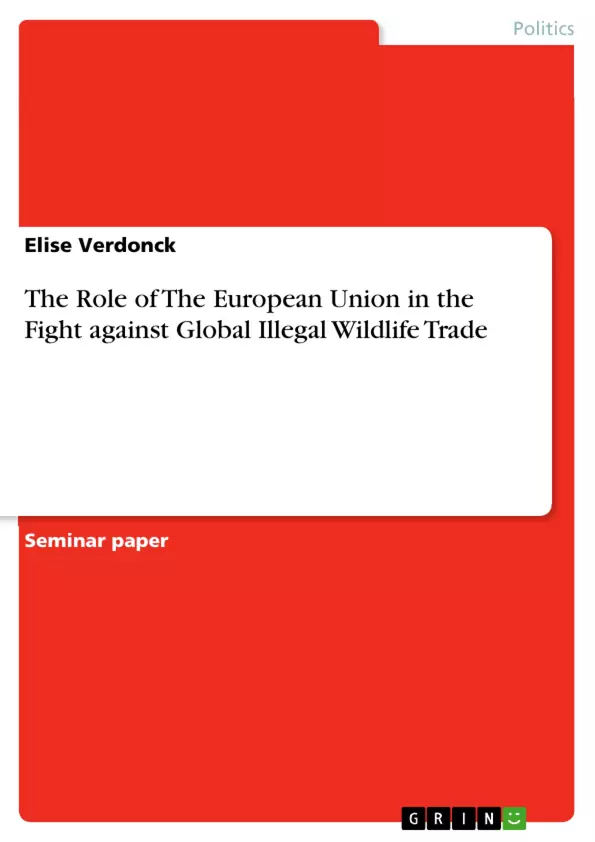The European Union (EU) ranks at the top of the list of global importers of wild animal and plant products. The estimated declared import value of the legal trade in wildlife products is worth billions of euros a year, and the extent of the EU market for wildlife products increases annually. The demand for wildlife animals and products is escalating worldwide. The majority of the wildlife trade into and within the EU is being exercised within the boundaries of the law, however illegal wildlife trade still occurs. Every year the enforcement authorities in the EU make over 5000 seizures. This illegal trafficking does not take into account sustainability concerns and may therefore result in the extinction of a species. Factors such as very high prices for wildlife products on the black market, low political awareness and low penalties aggravate the unsustainable and illegal trade. At the level of the EU many significant achievements in combating illegal wildlife trafficking have been accomplished. The biggest example of that are the EU Wildlife Trade Regulations, which implement the obligations for its member states under the Convention on International Trade in Endangered Species of Wild Fauna and Flora (CITES). More in-depth national, regional and international cooperation could even enhance the current initiatives in this context. The European Commission is currently working on a plan of action against illegal wildlife trade. This plan is the result of the Resolution on Wildlife Crime that was filed in 2014 by the European Parliament. This action plan will considerably strengthen the EU's response to illegal trade. Another key issue that needs to be dealt with is the sustainability of the global trade in wildlife. The controlling mechanisms implemented by CITES, that have been introduced worldwide, will always have their weaknesses. No permit system will guarantee that illegal wildlife trade will be banned. Criminal organisations always find the weak links in the systems and use them to plan their transits from one country to the other. Political initiatives to cease illegal wildlife trade will only be effective on the long term, if also the demand in the consuming countries will be tackled. The EU can play a huge role in the global wildlife trade by using its legislative powers to endorse particular objectives outside its territorial borders, such as reducing the demand in major consuming countries.
Inhaltsverzeichnis (Table of Contents)
- Executive Summary
- The Role of the European Union in the Fight against Global Illegal Wildlife Trade
- The EU's Role in Combating Illegal Wildlife Trade
- Sustainable Wildlife Trade
- Territorial Extension
- Due Diligence Regulation on Wildlife Trade
- Free Trade Agreements (FTA's)
- Minimum Sanction Level
Zielsetzung und Themenschwerpunkte (Objectives and Key Themes)
This essay explores the European Union's (EU) significant role in combating illegal wildlife trade, highlighting the challenges and opportunities associated with this global issue. The EU, as a major importer of wild animal and plant products, faces the responsibility of ensuring sustainability and legality in the trade. The essay emphasizes the importance of international cooperation and the need for effective regulatory frameworks to address the growing demand for wildlife products, particularly in countries like China, Vietnam, and Thailand.
- The EU's role in combating illegal wildlife trade
- Sustainable wildlife trade and the importance of demand reduction
- The use of territorial extension and due diligence mechanisms in environmental law
- The potential of free trade agreements (FTAs) to promote sustainable wildlife trade
- The need for harmonized sanctions and enforcement mechanisms
Zusammenfassung der Kapitel (Chapter Summaries)
- Executive Summary: This section provides a concise overview of the essay's main points, highlighting the EU's position as a major importer of wildlife products and the challenges posed by illegal trade. It also emphasizes the link between sustainable wildlife trade and development in developing countries.
- The Role of the European Union in the Fight against Global Illegal Wildlife Trade: This section delves into the EU's efforts to combat illegal wildlife trade, emphasizing the importance of the EU Wildlife Trade Regulations and the ongoing development of a plan of action against illegal wildlife trade.
- The EU's Role in Combating Illegal Wildlife Trade: This chapter explores the complexities of illegal wildlife trade, including the factors that contribute to its prevalence, such as high black market prices and low political awareness.
- Sustainable Wildlife Trade: This section examines the challenges of ensuring sustainable wildlife trade, acknowledging the limitations of existing mechanisms like CITES permits. The need for addressing demand in consuming countries is highlighted as crucial for long-term success.
- Territorial Extension: This chapter introduces the concept of territorial extension as a means for the EU to pursue environmental objectives outside its borders, using the example of the (Illegal) Timber Regulation of 2013.
- Due Diligence Regulation on Wildlife Trade: This section proposes a new due diligence regulation for wildlife trade, mirroring the existing system in the timber sector. The aim is to regulate the conduct of foreign operators who market their products within the EU.
- Free Trade Agreements (FTA's): This chapter explores the potential of incorporating wildlife protection charters into free trade agreements with major consuming countries, including China, Vietnam, and Thailand.
- Minimum Sanction Level: This section emphasizes the importance of harmonized sanctions within the EU for violations of wildlife trade regulations. The introduction of a minimum level of punishment is proposed to deter criminal organizations and strengthen enforcement.
Schlüsselwörter (Keywords)
This essay focuses on key aspects of the EU's role in combating illegal wildlife trade, including: illegal wildlife trade, sustainable wildlife trade, territorial extension, due diligence, free trade agreements (FTAs), CITES, European Union, environmental law, and international cooperation. The study emphasizes the need for effective regulatory frameworks, demand reduction strategies, and harmonized sanctions to address the global challenge of wildlife crime.
- Quote paper
- Elise Verdonck (Author), 2014, The Role of The European Union in the Fight against Global Illegal Wildlife Trade, Munich, GRIN Verlag, https://www.grin.com/document/284139



